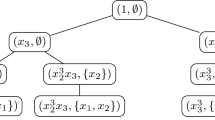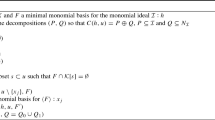Abstract
We extend the concept of Gröbner bases to relative Gröbner bases for ideals in and modules over quotient rings of a polynomial ring over a field. We develop a “relative” variant of both Buchberger’s criteria for avoiding reductions to zero and Schreyer’s theorem for a Gröbner basis of the syzygy module. As main contribution, we then introduce the novel notion of relative involutive bases and present an algorithm for their explicit construction. Finally, we define the new notion of relatively quasi-stable ideals and exploit it for the algorithmic determination of coordinates in which finite relative Pommaret bases exist.
Similar content being viewed by others
Notes
We omit the index \({\mathcal {I}}\), if it is clear from the context by which ideal we factor.
It should be noted that, by Lemma 7.3, it follows that this change may be sparser than the change that we need to transform \({{\,\mathrm{{\mathcal {J}}}\,}}\) into quasi-stable position.
References
Becker, T., Weispfenning, V.: Gröbner Bases: A Computational Approach to Commutative Algebra. In: Cooperation with Heinz Kredel, vol. 141. Springer, New York (1993)
Berkesch, C., Schreyer, F.-O.: Syzygies, finite length modules, and random curves. In: Commutative Algebra and Noncommutative Algebraic Geometry. Vol. I: Expository articles, pp. 25–52. Cambridge University Press, Cambridge (2015)
Buchberger, B.: A criterion for detecting unnecessary reductions in the construction of Gröbner-bases. Symbolic and algebraic computation, EUROSAM ’79, International Symposium, Marseille 1979, Lecture Notes Computer Science 72, 3–21 (1979)
Buchberger, B.: Ein Algorithmus zum Auffinden der Basiselemente des Restklassenringes nach einem nulldimensionalen Polynomideal. Ph.D. thesis, Universität Innsbruck (1965)
Buchberger, B.: Bruno Buchberger’s Ph.D. thesis 1965: an algorithm for finding the basis elements of the residue class ring of a zero dimensional polynomial ideal. Translation from the German. J. Symb. Comput. 41(3–4), 475–511 (2006)
Ceria, M., Mora, T.: Buchberger–Weispfenning theory for effective associative rings. J. Symb. Comput. 83, 112–146 (2017)
Ceria, M., Mora, T.: Toward involutive bases over effective rings. Appl. Algebra Eng. Commun. Comput. 31, 359–387 (2020)
Cox, D.A., Little, J., O’Shea, D.: Using Algebraic Geometry, vol. 185, 2nd edition. Springer, New York (2005)
Cox, D.A., Little, J., O’Shea, D.: Ideals, Varieties, and Algorithms. An Introduction to Computational Algebraic Geometry and Commutative Algebra. 4th revised ed. Cham: Springer (2015)
Faugère, J.-C.: A new efficient algorithm for computing Gröbner bases \((F_4)\). J. Pure Appl. Algebra 139(1–3), 61–88 (1999)
Faugère, J.-C.: A new efficient algorithm for computing Gröbner bases without reduction to zero \((F_5)\). In: Proceedings of the 2002 International Symposium on Symbolic and Algebraic Computation, ISSAC 2002, Lille, France, July 07–10, 2002, pp. 75–83. New York, NY: ACM Press (2002)
Gao, S., Volny, F.I.V., Wang, M.: A new framework for computing Gröbner bases. Math. Comput. 85(297), 449–465 (2016)
Gerdt, V.P.: Involutive algorithms for computing Gröbner bases. In: Computational Commutative and Non-commutative Algebraic Geometry. Proceedings of the NATO Advanced Research Workshop, 2004, pp. 199–225. Amsterdam: IOS Press (2005)
Gerdt, V.P., Blinkov, Y.A.: Involutive bases of polynomial ideals. Math. Comput. Simul. 45(5–6), 519–541 (1998)
Gerdt, V.P., Blinkov, Y.A.: Minimal involutive bases. Math. Comput. Simul. 45(5–6), 543–560 (1998)
Hashemi, A., Schweinfurter, M., Seiler, W.M.: Deterministic genericity for polynomial ideals. J. Symb. Comput. 86, 20–50 (2018)
Hausdorf, M., Sahbi, M., Seiler, W.M.: \(\delta \)- and quasi-regularity for polynomial ideals. In: Calmet, J., Seiler, W.M., Tucker, R.W. (eds.) Global Integrability of Field Theories, pp. 179–200. Universitätsverlag Karlsruhe, Karlsruhe (2006)
Hausdorf, M., Seiler, W.M.: An efficient algebraic algorithm for the geometric completion to involution. Appl. Alg. Eng. Commun. Comput. 13, 163–207 (2002)
Janet, M.: Sur les systèmes d’équations aux dérivées partielles. C. R. Acad. Sci. Paris 170, 1101–1103 (1920)
Kapur, D., Cai, Y.: An algorithm for computing a Gröbner basis of a polynomial ideal over a ring with zero divisors. Math. Comput. Sci. 2(4), 601–634 (2009)
La Scala, R., Stillman, M.: Strategies for computing minimal free resolutions. J. Symb. Comput. 26(4), 409–431 (1998)
Möller, H.M., Mora, T., Traverso, C.: Gröbner bases computation using syzygies. In: International Symposium on Symbolic and Algebraic Computation 92. ISSAC 92. Berkeley, CA, USA, July 27–29, 1992, pp. 320–328. Baltimore, MD: ACM Press (1992)
Mora, T.: De Nugis Groebnerialium 4: Zacharias, Spears, Möller. In Proceedings of the 2015 international symposium on symbolic and algebraic computation, ISSAC 2015, Bath, United Kingdom, July 06–9, 2015., pages 191–198. New York, NY: ACM Press, (2015)
Mora, T.: Zacharias representation of effective associative rings. J. Symb. Comput. 99, 147–188 (2020)
Norton, G.H., Sălăgean, A.: Strong Gröbner bases for polynomials over a principal ideal ring. Bull. Aust. Math. Soc. 64(3), 505–528 (2001)
Pommaret, J.-F.: Systems of Partial Differential Equations and Lie Pseudogroups. Gordon and Breach Science Publishers (1978)
Schreyer, F.-O.: Die Berechnung von Syzygien mit dem verallgemeinerten Weierstrass’schen Divisionssatz. Master’s thesis, University of Hamburg, Germany, (1980)
Seiler, W.M.: A combinatorial approach to involution and \(\delta \)-regularity. II: structure analysis of polynomial modules with Pommaret bases. Appl. Algebra Eng. Commun. Comput 20(3–4), 261–338 (2009)
Seiler, W.M.: Involution. The Formal Theory of Differential Equations and its Applications in Computer Algebra. Springer, Berlin (2010)
Seiler, W.M.: Effective genericity, \(\delta \)-regularity and strong Noether position. Commun. Algebra 40(10), 3933–3949 (2012)
Semenov, A.: On connection between constructive involutive divisions and monomial orderings. In: Computer Algebra in Scientific Computing. 9th International Workshop, CASC 2006, Chişinău, Moldova, September 11–15, 2006. Proceedings, pp. 261–278. Berlin: Springer (2006)
Spear, D.: A constructive approach to commutative ring theory. In: Proceedings of 1977 Macsyma Users’ Conference, pp. 369–376. NASA CP-2012 (1977)
Zacharias, G.: Generalized Gröbner bases in commutative polynomial rings. Master’s thesis, MIT, (1978)
Zharkov, A.Y., Blinkov, Y.A.: Involution approach to investigating polynomial systems. Math. Comput. Simul. 42(4), 323–332 (1996)
Acknowledgements
The research of the first author was in part supported by a grant from IPM (No. 99130215). The third author thanks Cristina Bertone and Francesca Cioffi for their hospitality in Torino and for bringing this problem to his attention. We furthermore thank an anonymous referee for pointing out to us the work by Ceria and Mora on effectively given rings.
Author information
Authors and Affiliations
Corresponding author
Additional information
Publisher's Note
Springer Nature remains neutral with regard to jurisdictional claims in published maps and institutional affiliations.
Rights and permissions
About this article
Cite this article
Hashemi, A., Orth, M. & Seiler, W.M. Relative Gröbner and Involutive Bases for Ideals in Quotient Rings. Math.Comput.Sci. 15, 453–482 (2021). https://doi.org/10.1007/s11786-021-00513-4
Received:
Revised:
Accepted:
Published:
Issue Date:
DOI: https://doi.org/10.1007/s11786-021-00513-4




